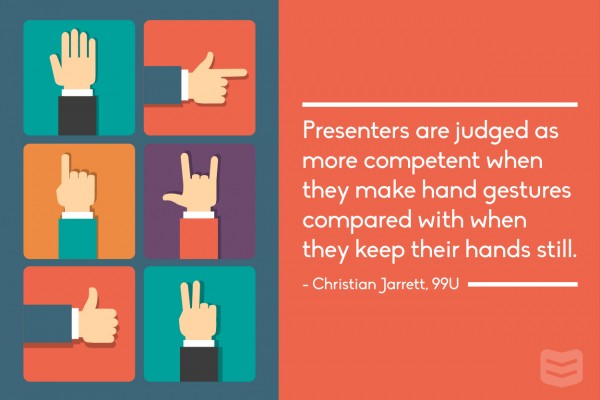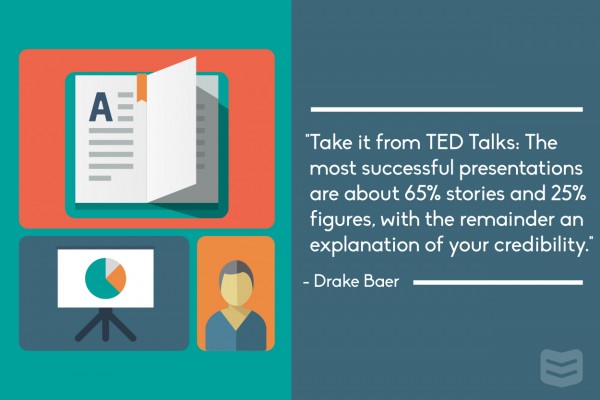Presentations are a gamble; they’re risky. You invest valuable time and money, but you can’t predict the presentation climate that you will be dealt. You cannot calculate the exact mood of the audience or control all variables of the situation. To succeed, you must be bold, and come prepared with an ace up your sleeve. You need to be a master of persuasion.
Even if your goal is only to inspire or inform, you still need to persuade your audience to pay attention. If you need to compel your audience to take action, persuasion is an obvious essential.
The Ace Up Your Sleeve: 6 Proven Methods of Persuasion
#1: Use Your Hands
Loosen up. Let your hands gesture naturally during your presentation.
Research has shown that presenters are judged as more effective and competent when they make hand gestures compared with when they keep their hands still, according to The 4 Ways You Can Use Body Language To Influence Success by Christian Jarrett.

While gesturing, be especially aware of how you use your palms. In his TEDx talk, Body Language, the power is in the palm of your hands, Allan Pease uses humor, stories, case studies, and audience interaction to deliver a compelling case for the importance of using your palms wisely when speaking. There are more connections between your brain and the palm of your hands than any other body part, according to Pease. So clearly, the palms have evolved as an important part of human brains, Pease concludes.
Pease demonstrates how the palm orientation of a speaker can transmit a signal that appeals to your ancient brain. Depending on which signal is transmitted, a speaker can either gain the trust and attention of the audience, or be rejected by the audience, according to Pease. In one of the case studies mentioned by Pease, palm orientation was tested; the study concluded the palm up speaker had up to 40% more retention of the deal than the palm down speaker.
Speaking with your palms up will make you more likable and persuasive. If you speak with your palms down, you will be perceived as threatening and controlling. To drive this message home, Pease demonstrates the Nazi salute. The palms down gesture seems aggressive. Pease then flips the salute from palms down to a palms up gesture. The audience laughs because the revised salute is comical. Pease was transformed from intimidating to lovable. Go watch it for yourself; the entire video is phenomenal.
#2: Be A Wordsmith
Be selective about the words that you choose to use during your presentations. For example, lean heavily on words that will strike an emotional chord with audience members. Compared to words with neutral connotations, emotional words have a more lasting effect on audience members, according to Memory enhancement for emotional words: Are emotional words more vividly remembered than neutral words?, a study by MIT researchers Elizabeth A. Kensinger and Suzanne Corkin. More precisely, the study concluded:
In the present investigation, we examined whether there was a qualitative memory benefit for emotional, as compared with neutral, words. The results of six experiments confirmed that there is such a benefit: Across all tasks, details associated with the presentation of words (assessed through subjective and objective measures) were more likely to be remembered for emotional than for neutral items.
Take your word curation to the next level by integrating some of the most influential words into your presentations:
YOU: Use the pronoun you during presentations to get your audience excited. Rewrite sentences, replacing the I pronoun with the you pronoun, to put the focus on the audience and not on yourself. In addition, if you are delivering a presentation to only to a few people, consider using their first names during the presentation. Don’t force it though; be natural when addressing audience members directly.
FREE: The word free is thrown in our faces constantly by advertisers and purveyors. Yet, the word maintains some powers of persuasion. However, be strategic about your use of free to maintain the value of your message, while also tapping into the influential power of the word.
BECAUSE: In Magic Words: The Science and Secrets Behind Seven Words That Motivate, Engage, and Influence, author Tim David describes a Harvard Study by Ellen Langer to demonstrate the persuasive nature of the word because. In the study, participants were asked a small favor and 60% complied. When the word because and an explanation for the request were added, compliance rates jumped to 94%. If you want audience members to participate in your presentation, give them a reason for your request.
INSTANTLY: The word instantly makes events or experiences seem easy and exciting. If you can honestly and tactfully use the word instantly as part of your call-to-action at the end of your presentation, go for it. Chances are, your results will improve.
To learn more, watch this video by Business Insider:
#3: Tap Into The Five Senses
Use the power of the five senses to stack the deck in your favor for your next presentation. For example, if technical difficulties delay your presentation, keep the audience relaxed by playing some pleasant music. Pleasant music played while you’re placed on hold keeps callers on the line longer, Thai Nguyen explains in his article The Art of Persuasion: 10 Brain Hacks to Leverage in Business and Life. To avoid the struggle of trying to persuade an angry audience, use music to keep people happily on hold for you.
In addition, watch the video below to learn the basics of the physiological responses to color that influence moods and behaviors. Use colors wisely to maximize the persuasive potential of your presentation design.
#4: Tell Stories
Studies prove stories are more persuasive than logical arguments. Take it from TED Talks: The most successful presentations are about 65% stories and 25% figures, with the remainder an explanation of your credibility, Drake Baer reports in his article 9 Proven Ways To Get People To Take You Seriously.

Summarizing a study by Timothy Brock and Melanie Green, Gregory Ciotti explains the secrets to crafting a persuasive story in his article The Psychology of Storytelling: Transportation Leads to Persuasion. Ciotti suggests using suspense, detailed imagery, and literary techniques such as metaphors to deliver a story that will influence your audience.
#5: Utilize Aversion To Loss
Ask your audience to imagine performing the task that you want to persuade them to complete.
As strange as it may sound, the brain literally cannot tell the difference between imagining reality, and actually experiencing reality, says Bnonn Tennant in his article How To Use These 3 Hypnotic “Power Words” To Covertly Increase Your Conversion Rates.
Once your audience imagines an experience, they emotionally and mentally own it. As a result, your audience is less likely to reject the action that you are requesting. That’s because our emotional reaction to loss is twice as intense as our joy in gain, Thai Nugyen explains.

#6: Be Likable
Likable presenter are more persuasive than presenters who cannot connect to the audience. In the video below, Science of Persuasion, Dr. Robert Cialdini shares tips for being a likable speaker. Specifically, Cialdini explains that people tend to like speakers who are: similar to them, generous with compliments, and cooperative.
Before delivering a presentation, thoroughly research your audience. When you take the stage, be prepared to demonstrate commonalities between yourself and the audience members, and also compliment the audience. If you are working the room after the presentation, cooperate with requests from audience members who need a final push of persuasion.
Warmth is another characteristic of likable leaders. In the Harvard Business School study, The Dynamics of Warmth and Competence Judgments, and their Outcomes in Organizations, researchers report that leaders need to be perceived as warm, even more so than competent, to be persuasive. Although projecting competence is clearly important, neglecting to demonstrate trustworthiness/warmth – a psychological conduit for influence – makes it very difficult for leaders to gain loyalty and to be persuasive in a sustainable way. Among other techniques, researchers suggest flashing a natural smile during appropriate moments in your presentation to project a warm demeanor.
Conclusion: Consider the impact your hand gestures and word choices will have on your audience when preparing for a presentation. In addition, look for ways to be a likable presenter, as well as ways to utilize storytelling, and the power of the five senses. Lastly, help your audience develop a sense of ownership of your ideas by asking the audience to use their imagination. Stack the deck in your favor; master the art of persuasion before your next presentation.
